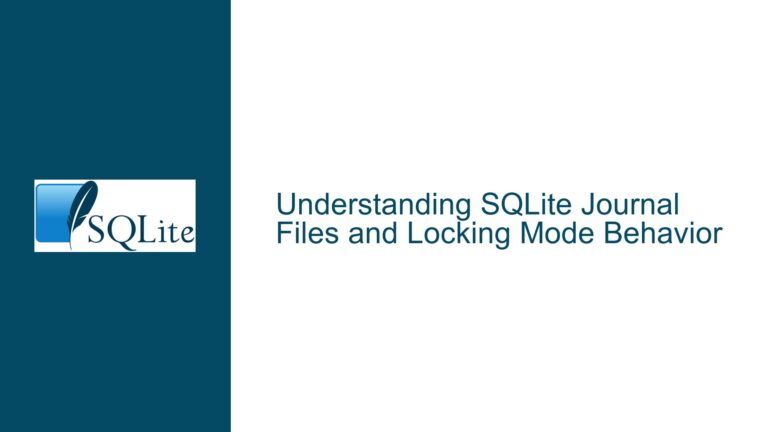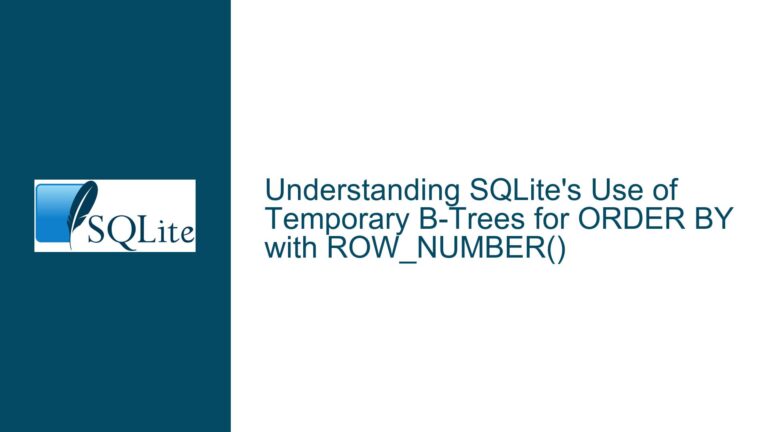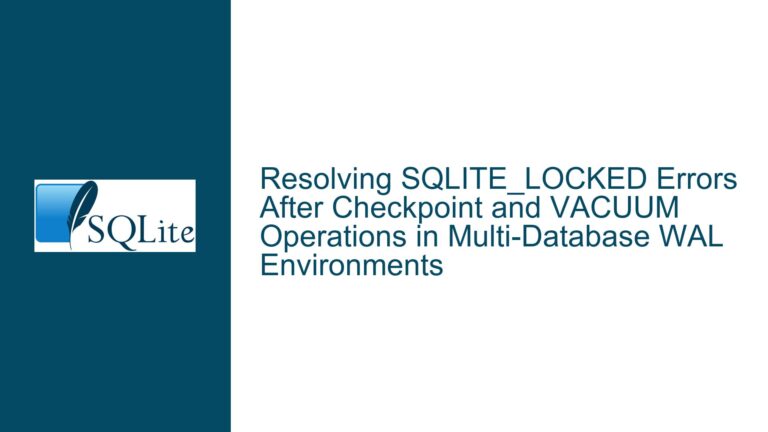Resolving SQLite Parser Stack Overflow in Deeply Nested Queries
Understanding the "Parser Stack Overflow" Error in Nested SQLite Queries
The "parser stack overflow" error in SQLite occurs when the depth of nested expressions or subqueries in a SQL statement exceeds the predefined limit of the parser’s internal stack. This stack is a fixed-size memory structure used during the parsing phase to track syntactic elements as the SQL statement is processed. When the parser encounters a query with deeply nested subqueries, correlated expressions, or complex joins, each layer of nesting consumes a portion of this stack. If the cumulative depth exceeds the allocated stack size (controlled by the YYSTACKDEPTH compiler directive), SQLite aborts parsing and returns the error.
The issue is particularly prevalent in ORM-generated queries or applications that rely on dynamic SQL generation, where encapsulation patterns produce deeply nested subqueries. For example, a query might involve multiple layers of EXISTS clauses, nested SELECT statements, or correlated subqueries that reference outer tables. While the SQL syntax itself is valid, SQLite’s parser struggles to process such structures due to its stack-based parsing algorithm. The problem is exacerbated by SQLite’s default configuration, which prioritizes minimal memory footprint and performance over accommodating unusually deep nesting.
Two canonical examples from the discussion highlight this limitation:
- A
COUNT(*)query with a chain of correlatedEXISTSsubqueries spanning 17 levels of nesting. - A
SELECT *query with 32 nested subqueries, each encapsulated within theFROMclause of the parent.
In both cases, the parser stack overflows not because the logical depth of the query exceeds SQLite’s expression depth limit (SQLITE_MAX_EXPR_DEPTH, default 1000), but because the grammar rules used to parse the SQL text require multiple stack entries per syntactic element. For instance, parsing a nested SELECT statement involves pushing tokens like FROM, WHERE, and subquery delimiters onto the stack, which consumes more levels than the logical nesting depth suggests. This discrepancy between apparent query complexity and actual parser stack usage is a key source of confusion for developers.
Root Causes of Parser Stack Limitations in SQLite
The parser stack overflow error arises from three interrelated factors:
Fixed Parser Stack Allocation
SQLite’s parser is generated by the Lemon parser generator, which uses a pushdown automaton to process SQL syntax. By default, the stack size for this automaton is set to 100 entries (YYSTACKDEPTH=100). Each entry corresponds to a state or token being processed during parsing. While 100 entries are sufficient for most hand-written queries, ORM-generated SQL often introduces redundant nesting that rapidly depletes the stack. For example, a singleEXISTSsubquery with correlated conditions might consume 5-10 stack entries depending on its structure. In the provided examples, the cumulative stack usage exceeds 100 entries long before the logical nesting depth reaches theSQLITE_MAX_EXPR_DEPTHlimit.Memory and Performance Tradeoffs
SQLite is designed for embedded systems with constrained resources. To minimize memory usage and maximize performance, the parser stack is allocated as a static array on the process stack during compilation. IncreasingYYSTACKDEPTHto accommodate rare edge cases would bloat memory consumption for all users. For instance, raising the default stack depth from 100 to 1000 would require an additional 21.6 KB of stack space per parser invocation (24 bytes per entry on 64-bit systems). On devices with limited RAM, this could lead to stack exhaustion or fragmentation. Furthermore, switching to dynamic heap allocation for the parser stack (e.g.,YYSTACKDEPTH=0) incurs a 1.5–3.4% performance penalty due to malloc/free overhead and pointer indirection—a significant cost given SQLite’s use in high-throughput scenarios.ORM-Induced Query Complexity
Object-Relational Mappers (ORMs) like Doctrine or ATK Data often generate SQL by composing modular query fragments. While this promotes code reuse, it can result in overly nested queries that mirror the structure of the object graph rather than optimizing for the database engine. For example, an ORM might represent a filtered join as a nestedEXISTSclause instead of a flattenedINNER JOIN. These patterns are syntactically valid but stress the parser’s stack due to redundant nesting. Unlike PostgreSQL or MySQL, which use bottom-up parsers with dynamic stack allocation, SQLite’s Lemon-generated parser cannot dynamically grow its stack, making it vulnerable to such edge cases.
Mitigating and Resolving Parser Stack Overflows
1. Recompiling SQLite with Increased Stack Depth
For applications requiring deep query nesting, the immediate fix is to recompile SQLite with a larger YYSTACKDEPTH. This approach is viable for custom deployments or statically linked applications.
Steps:
- Download the SQLite amalgamation source.
- Compile with
-DYYSTACKDEPTH=1000(or higher):gcc -DSQLITE_CORE -DYYSTACKDEPTH=1000 -c sqlite3.c -o sqlite3.o - Link the custom build into your application.
Tradeoffs:
- Increases memory usage per parser invocation.
- Not feasible for system-wide SQLite installations (e.g., Debian packages).
2. Leveraging Hybrid Stack Allocation (SQLite ≥3.46.0)
Starting with version 3.46.0, SQLite employs a hybrid stack allocation strategy:
- The parser initially uses a fixed-size stack allocated on the process stack.
- If the stack overflows, additional space is dynamically allocated from the heap.
This approach balances performance and flexibility. The fixed-size portion avoids heap allocation overhead for most queries, while the dynamic extension handles edge cases without bloating memory usage.
Implementation Details:
- The
sqlite3Parserfunction checks stack depth during state transitions. - On overflow, the stack is reallocated using
sqlite3Realloc(), preserving existing state. - Benchmarks show <0.2% performance regression compared to the static stack.
Adoption:
- Upgrade to SQLite 3.46.0 or later.
- No configuration required—dynamic extension is automatic.
3. Optimizing ORM-Generated Queries
Reducing query nesting depth alleviates parser stack pressure. Strategies include:
Flattening Subqueries: Replace nested
EXISTSclauses withJOINoperations.
Example:-- Original nested query SELECT * FROM user u WHERE EXISTS ( SELECT 1 FROM ticket t WHERE t.user_id = u.id AND EXISTS ( SELECT 1 FROM country c WHERE c.id = t.country_id ) ); -- Flattened version SELECT DISTINCT u.* FROM user u JOIN ticket t ON t.user_id = u.id JOIN country c ON c.id = t.country_id;Materializing Intermediate Results: Use temporary tables or CTEs to break down complex queries.
Example:WITH user_tickets AS ( SELECT user_id, country_id FROM ticket ) SELECT u.* FROM user u JOIN user_tickets ut ON ut.user_id = u.id JOIN country c ON c.id = ut.country_id;Disabling Query Encapsulation: Configure the ORM to generate simpler SQL by avoiding unnecessary subquery wrapping. For Doctrine, this might involve custom hydrators or DQL optimizations.
4. Runtime Configuration (Advanced)
For environments where recompilation isn’t feasible, consider these workarounds:
- Query Simplification: Use a preprocessing layer to rewrite deeply nested SQL. Tools like pgFormatter or custom scripts can identify and flatten excessive nesting.
- Connection Pooling with Custom Builds: Deploy a sidecar service hosting a custom SQLite build with increased
YYSTACKDEPTH, and route problematic queries through this service.
5. Community and Distribution Advocacy
Lobby Linux distributions (e.g., Debian, Ubuntu) to ship SQLite with a higher default YYSTACKDEPTH. Given that server environments are less memory-constrained than embedded systems, a value of 500–1000 could mitigate stack overflows without significant drawbacks.
Conclusion
The "parser stack overflow" error in SQLite stems from the interplay between its parser’s static stack allocation and the deep nesting patterns of ORM-generated queries. While recompiling with a larger stack or upgrading to SQLite 3.46.0 provides immediate relief, long-term solutions involve query optimization and community-driven configuration changes. By understanding the parser’s mechanics and adopting hybrid allocation strategies, developers can balance performance, memory usage, and query complexity effectively.






